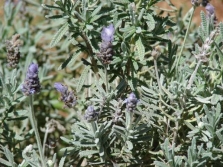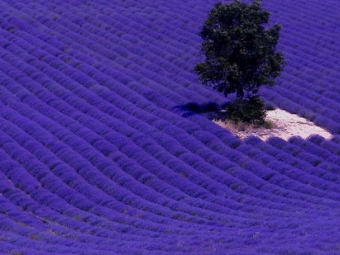Lavender

Lavender is an evergreen perennial shrub. Its height ranges from 60 to 90 cm. The lower branches are very branched and have many grassy shoots. The leaves are opposite, 2.5 - 6 cm long, up to 1 cm wide. The root is woody. Lavender has very beautiful flower stalks. Their color varies from purple-lilac to white, blue or pink. Flowers are collected in spikelets. From June to August, the plant enters the flowering phase, and by September the seeds ripen. Lavender seeds are small brown nuts.

Kinds
Lavender has 45 species. Let's get acquainted with the most popular of them:
- Lavandula angustifolia or real lavender. They call it English, spikelet, narrow-leaved. Usually, when talking about lavender, this type of plant is meant. The shrub grows in different directions by 1 m. It has the same height. In dwarf subspecies, the height is about 30 cm. One inflorescence is located on the stem of the plant. (Photo 1)
- Lavandula tifolia or broadleaf lavender. This species is characterized by a pronounced aroma and the presence of three inflorescences on one stem (photo 2).
- Lavandula intermedia Emeric. It is called Dutch lavender, hybrid or lavandin. This is a hybrid obtained naturally from the above two species. It is more thermophilic, therefore it is cultivated in the south and in the center of Europe. The plant is quite large. Its height is about 2 meters. The bush also grows up to 2 m wide.Its long inflorescences are characterized by curvature. This type of lavender blooms in July. (photo 3)
- Lavandula pedunculata. It is called petiolate lavender. She has very unusual bright purple flowers. This species belongs to ornamental plants. It is grown in Spain, Portugal, Morocco. Well, the Russians can grow it on their windowsill. (photo 4)
- Lavandula dentate. Translated, it sounds like jagged lavender. This type of lavender has rather large flowers, and its soft, rugged leaves are cast in silver. She loves warmth very much, so she can only be grown in a pot on the windowsill. (photo 5)





Where does it grow?
Lavender is a Mediterranean plant. In our country, lavender is grown in the Crimea, the Caucasus, and the Krasnodar Territory. Lavender is cultivated in Moldova and Central Asia. It is found in India, Arabia, southern Europe, the Canary Islands and Africa (south and east).


spice making method
The collection of raw materials begins seven days after the flowering of the plant. Suitable spikelets with flowers. Harvest time is in the morning when the flowers are already open. Cut spikelets are dried in a suspended form. For drying, use a dark and well-ventilated area. The sun is detrimental to lavender flowers. Under its influence, they fade.
But the leaves are harvested before the lavender blooms. Dried raw materials are used in powdered form. The taste of the spice is spicy, tart, slightly bitter. Lavender has a very strong scent.



Peculiarities
Lavender is a honey plant, which is very fond of bees and butterflies. Lavender honey is very tasty and healthy, has a unique aroma.


Characteristics
Lavender is a medicinal, essential oil and ornamental plant. In general, lavender is a hardy, drought tolerant plant.Insect pests find it completely unattractive. The life span of lavender is approximately ten years.

Nutritional value and calories
100 g of lavender contains the following components:
| Squirrels | Fats | Carbohydrates | calories |
|---|---|---|---|
| 4 gr. | 0.7 gr. | 0.2 gr. | 23 kcal |
Chemical composition
- Essential oil: about 4.5%
- Tannins
- Ursolic acid
- Resin
- Gerniarin
- Coumarin
- Triterpene compounds
- Borneol
- vitamins
- Minerals
Beneficial features
- Lavender has analgesic and sedative properties, useful in neurotic conditions.
- Improves sleep.
- Stimulates appetite.
- Normalizes acidity and blood pressure.
- Helps with arrhythmias.
- Fights colds.
- Relieves spasms.
- Lavender is the enemy of intestinal parasites.
- Has a wound healing effect.
- Removes puffiness.

Harm
- Lavender can cause allergic reactions. Therefore, before taking it, you should make sure that your body can tolerate this plant.
- Lavender is a powerful plant. In this regard, before using it, it is necessary to consult a doctor.
- Lavender should not be used by pregnant women, especially during the first three months.
- The use of lavender after an abortion is strictly prohibited.
- Do not use lavender and medicines containing iodine and iron at the same time.

Application
In cooking
Cooks use only two types of lavender to prepare their masterpieces: broad-leaved and medicinal.
- Lavender is used in various salads, sauces.
- It is flavored with vegetable and fish soups.
- Lavender goes well with meat dishes, especially lamb.
- It is used in the preparation of desserts and for their decoration.
- Lavender flavors alcoholic and non-alcoholic drinks.

lavender sugar
At home, you can make lavender sugar, which can be used in the preparation of confectionery or simply added to regular tea. You need to put a sprig of lavender in sugar and leave it there for a week. The container must be sealed. After the allotted time, the sugar will be saturated with the spicy aroma of lavender.

lavender ice cream
Try to surprise your guests with an unusual dessert: make lavender ice cream. You will need 3 cups of cream (35% fat), to which 2 tbsp. spoons of lavender flowers. Put this mixture on fire. Remove when it boils and leave for 15 minutes so that the lavender transfers its wonderful aroma to the cream. Whilst the creamy lavender base is infused, beat 4 egg yolks with 1 cup of sugar, then continue beating while adding 2 teaspoons of flour. Strain the cream to separate the lavender from it and pour in the egg mixture. Put everything on a slow fire, stirring with a whisk. The mixture should thicken. After that, it should be filtered through a sieve. Put our still liquid ice cream in the refrigerator, and then in the freezer.

In medicine
- From lavender, you can prepare a useful syrup that will help cure colds and laryngitis, relieve headaches and heart palpitations. You will need fresh lavender inflorescences in the amount of 200 g. They are poured with 0.5 liters of boiling water and insisted for a day, wrapping the vessel with something warm. The mixture is filtered, the inflorescences are squeezed well. Fresh flowers are taken again (in the same quantity) and poured with the resulting broth. The procedure is repeated. Further, 0.5 kg of honey or sugar is added to the strained broth. The mixture is put on fire. It should be boiled with constant stirring until the syrup becomes thick. Take this delicious medicine half an hour before meals, 1 teaspoon 3 times a day.
- Lavender decoction can be used as an antispasmodic.
- A bath with the addition of lavender decoction will relax and relieve fatigue after a hard day. It is no coincidence that lavender is called the "aroma of relaxation."
- For insomnia, you can take 100 g of lavender flowers, place them in a bag sewn from cotton fabric. Before going to bed, warm this bag on a regular radiator of a home heating system, wrinkle it a little and put it near the pillow. To store such a bag, any plastic bag is suitable.


At home
- Lavender is used as an ornamental plant in the garden. She can beautifully emphasize the border. It has been successfully used in landscape design.
- Lavender is a plant that the Colorado potato beetle does not like. Therefore, it is used in the fight against potato pests. It is enough to place lavender bushes between your plantings.
- Another use of lavender is the decoration of the room and at the same time its aromatization.

Varieties
The most famous varieties of lavender are Alba (its flowers are white), Beechwood Blue (purple-blue flowers). Rosea has pink inflorescences, while Gem has dark purple inflorescences. Lavender also has representatives of a dwarf variety: Nana Alba (white inflorescences), Little Lottie (pale pink flowers).

cultivation
Lavender loves sunlight, so if you want it to please you with long and abundant flowering, you do not need to plant it in the shade. As fertilizers, those that contain potassium are suitable. But nitrogen-containing fertilizers and manure are undesirable for lavender - there will be few flowers, and many leaves.
There are two ways to grow lavender.
seeds
Before engaging in the direct planting process, the seeds must be hardened. To do this, they are simply placed in the lower compartment of the refrigerator, where they spend a month.Next, the seeds are mixed with sand. They need to be constantly moisturized. After another month, we start landing. Sand and lavender seeds are placed in their designated place and sprinkled on top with a small layer of soil. Lavender blooms in 1-2 years. The first years of life, the plant spends all its vitality on strengthening its root system as much as possible.
For growing lavender seeds in a pot, see the following video.
Branches and layering
To do this, in an already adult plant, a branch is bent to the ground and sprinkled with soil. To immobilize the layering, it is recommended to press it down with a small load. After a few months, roots appear and the layers can be separated from the main bush. It is cut off with a sharp knife, and the cut is treated with crushed coal to avoid rot.
At home
If you still decide to grow lavender on your windowsill, then keep in mind that the pot for planting should be about 30 cm in diameter and 2 liters in volume. Place the pebbles at the bottom of the pot. This will provide the plant with good drainage. Add a mixture to the soil, which contains crushed eggshells (a small amount), sand and peat. The ambient temperature must be at least +15°. Do not forget that lavender is a photophilous plant.


Care
Watering lavender is carried out with water, which was previously settled and acquired room temperature.
When watering, the leaves also need to be moistened, do not forget to spray them.
With the advent of winter, watering should be reduced, and lavender should be removed from radiators and batteries. At the end of summer, dry stems need to be removed, and the plant should be trimmed a little.Lavender is transplanted into a new pot with the advent of spring.
We recommend watching the following video about the features of growing lavender.
Interesting Facts
- The name of the plant lavender was derived from the Latin lava, which means in translation wash. It was added to the water when taking baths.
- Bulgaria ranks first in the industrial cultivation of lavender. This country produces about 140 tons of plants per year.
- The ancient Egyptians used lavender to embalm pharaohs. It is known that when opening the tombs, archaeologists found urns, opening which they felt the wonderful aroma of lavender. It has been preserved after 3 thousand years.
- During the Middle Ages, it was believed that lavender warded off witches and evil spirits. The French even carried bundles of this grass with them and attached it at the front door to protect their house from all evil spirits.
- Lavender is considered the flower of love. Therefore, it was used in love magic. In addition, lavender is believed to promote prophetic dreams.


















I really love lavender! I have a lavender theme in everything, even in furniture) Provence style. And I brought lavender from Provence and now I add it to different dishes))
I love lavender, it's good for health.